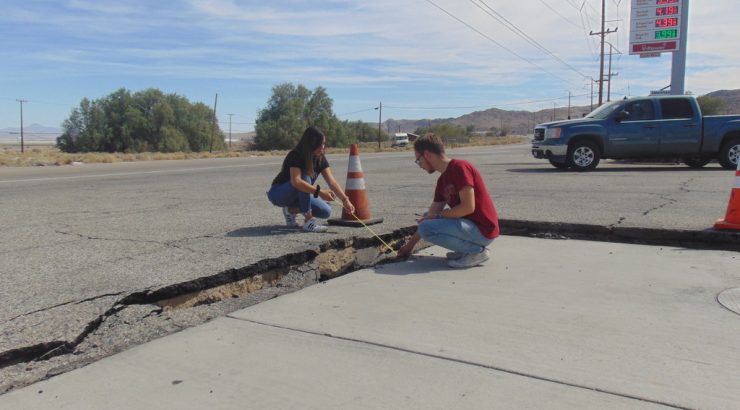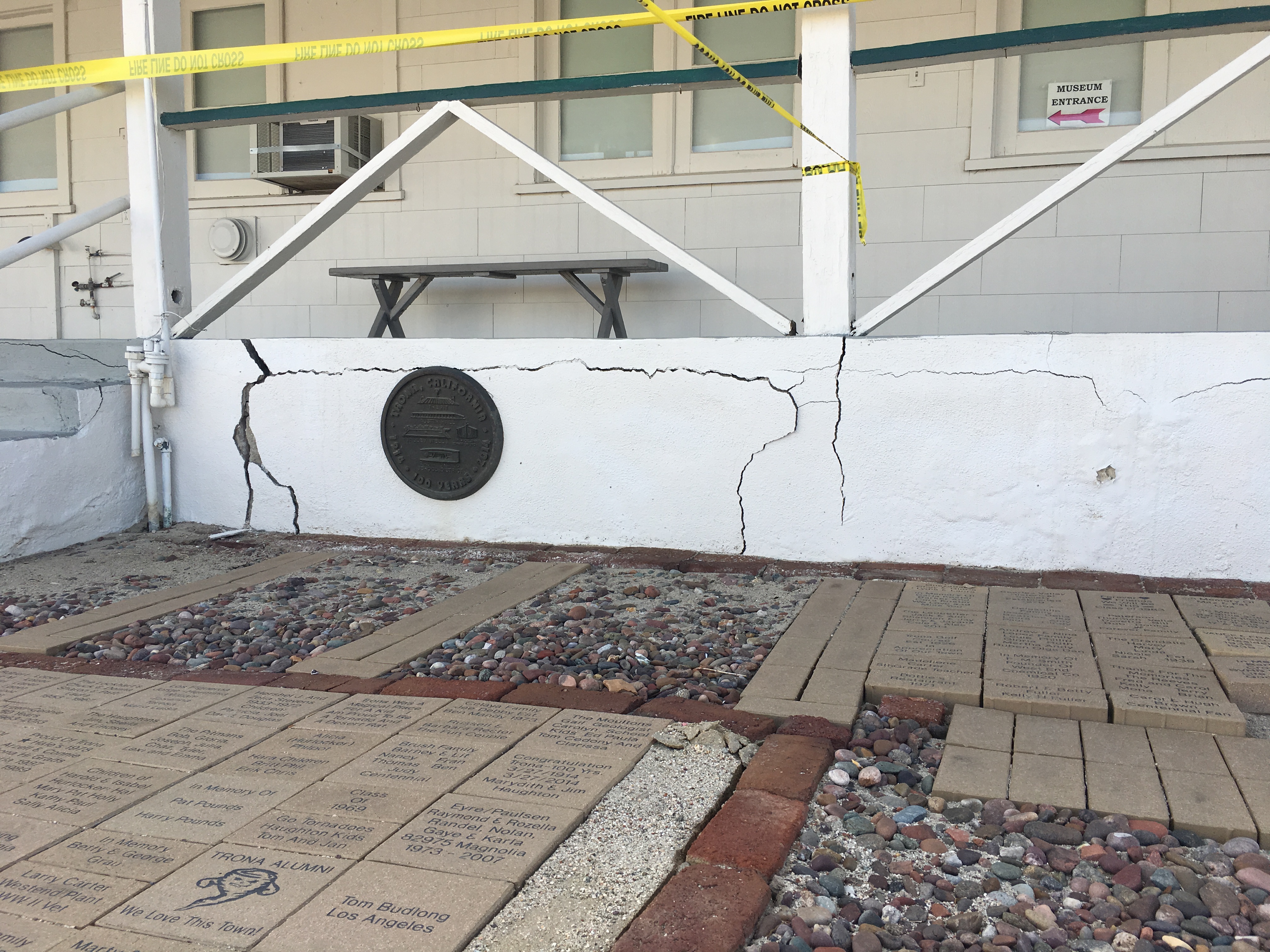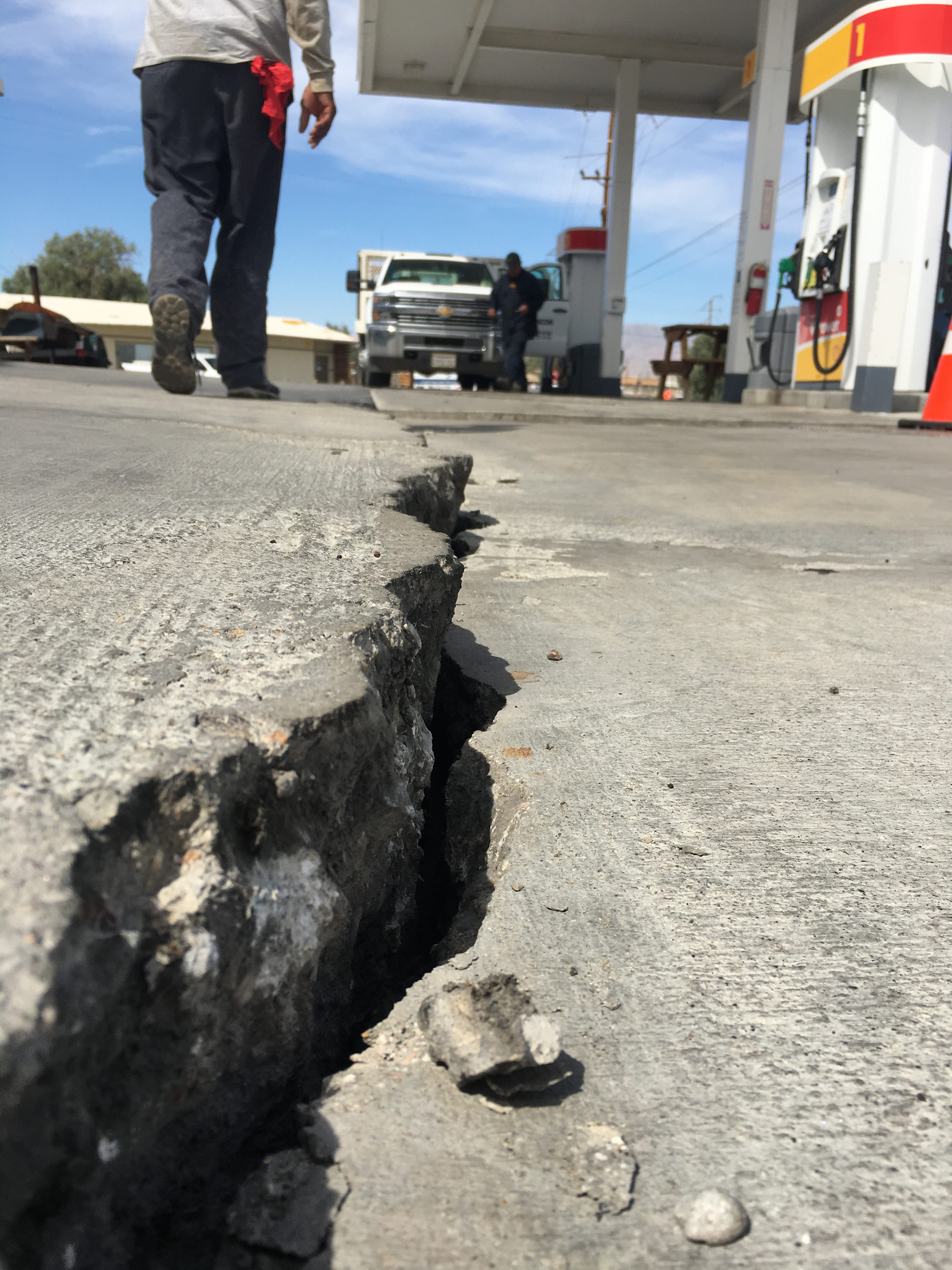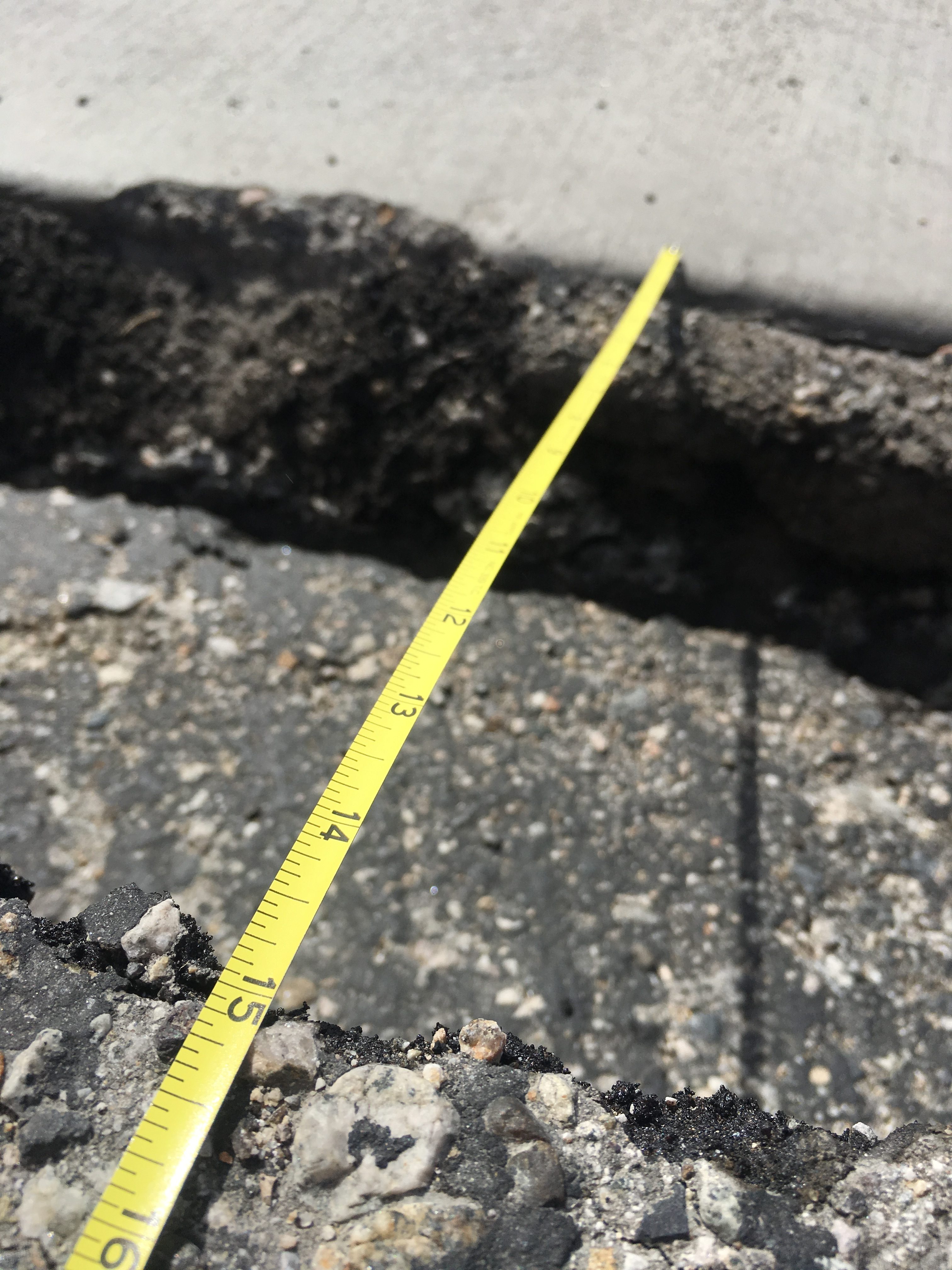
Complacency in California How Residents of Ridgecrest Mistook a 6.4 Magnitude Earthquake for a Bomb
July 25, 2019
By Muhammad Karkoutli, Babbie Center Undergraduate Research Fellow (’20) and Syd Kotar, Henley Lab Undergraduate Research Fellow (’19)
 JUST four days following two earthquakes of magnitude 6.4 and 7.1 that occurred on July 4th and 5th respectively, we drove to Ridgecrest and Trona. These are two cities in Southern California that were at the epicenter of the quakes. The goal of the trip was to hone our fieldwork skills through observing the physical aftermath of the earthquakes, gain insight into how prepared the residents were, and compare their disaster or emergency preparedness with that of Orange County. It was also a great chance to get out of the lab and into the field, under the supervision of a faculty member. We spoke with local residents about their experiences and how they responded during the quakes. We measured cracks that were 15 inches wide. The following is what we found.
JUST four days following two earthquakes of magnitude 6.4 and 7.1 that occurred on July 4th and 5th respectively, we drove to Ridgecrest and Trona. These are two cities in Southern California that were at the epicenter of the quakes. The goal of the trip was to hone our fieldwork skills through observing the physical aftermath of the earthquakes, gain insight into how prepared the residents were, and compare their disaster or emergency preparedness with that of Orange County. It was also a great chance to get out of the lab and into the field, under the supervision of a faculty member. We spoke with local residents about their experiences and how they responded during the quakes. We measured cracks that were 15 inches wide. The following is what we found.
“I thought it was a bomb!” said a teenager from Ridgecrest. The teenager mistook the 6.4 magnitude earthquake on July 4th for a bomb from the nearby China Lake Naval Base. It should also be noted that this young Ridgecrest resident was not the only one to state that they mistook the earthquake for a bomb going off at the Naval Base. Although the teenager was not harmed, his misidentification could have been costly. For instance, one mobile-home went up in flames. Brick walls had crumbled along West Reeves Avenue.
This teenager also stated that he knew to get under a table during an earthquake from years of practice at school, yet when the second earthquake hit while he was at work, he ran outside because his coworkers had done so. It is in moments like these where people may not remember or even act on “Drop, Cover, and Hold On” and may instead follow the instinctive actions of their peers.
This is not to blame the teenager for his actions because quite frankly this is to be expected, especially from a younger demographic that has never experienced earthquakes of these magnitudes in their lives before. When the proximity of the naval base is factored in, we can only hope that confusing earthquakes for bombs does not occur in the future.
 Young Californians statewide are at risk for being unprepared when earthquakes hit. For many young residents of Ridgecrest and Trona, the recent earthquakes had been their first. Earthquake drills at school and memorizing phrases ought to prepare Californians in times of disaster. However, fear coupled with apathy can cloud Californians’ ability to take life-saving action. For instance, the teenager knew to drop and take cover under a table during an earthquake and yet did not. The degree to which fear, apathy, or peer-pressure influenced the teenager to run outside with his coworkers is difficult to say. However, what can be said is that the teenager was unprepared when an earthquake hit. Fortunately for this teenager and young Californians there is ample evidence that shows preparing a natural disaster kit is the most effective way to mitigate the effects of quakes and other disasters. Such kits include food, water, a flashlight, extra batteries, medicine, etc. Yet, according to the Chapman University Survey of American Fears 2018 (CSAF), only 29.8 percent of Americans have put together an emergency supply kit.
Young Californians statewide are at risk for being unprepared when earthquakes hit. For many young residents of Ridgecrest and Trona, the recent earthquakes had been their first. Earthquake drills at school and memorizing phrases ought to prepare Californians in times of disaster. However, fear coupled with apathy can cloud Californians’ ability to take life-saving action. For instance, the teenager knew to drop and take cover under a table during an earthquake and yet did not. The degree to which fear, apathy, or peer-pressure influenced the teenager to run outside with his coworkers is difficult to say. However, what can be said is that the teenager was unprepared when an earthquake hit. Fortunately for this teenager and young Californians there is ample evidence that shows preparing a natural disaster kit is the most effective way to mitigate the effects of quakes and other disasters. Such kits include food, water, a flashlight, extra batteries, medicine, etc. Yet, according to the Chapman University Survey of American Fears 2018 (CSAF), only 29.8 percent of Americans have put together an emergency supply kit.
In conjunction with the CSAF, a recent survey conducted by Chapman University on ‘Disaster Preparedness’ in Orange County found that 61.1 percent of Orange County residents fear ‘devastating earthquakes,’ but only 44.9 percent have prepared an emergency supply kit and only 45.5 percent have actually put together a plan for what course of action to take if a natural disaster were to occur. So although more Orange County residents have put together a plan and an emergency supply kit than the national average, there remains a majority who have not prepared for natural disasters. And this is not due to ignorance. The survey also found that 96 percent of Orange County residents agreed that keeping an emergency supply kit improves their chances of surviving a natural or man-made disaster. So, if not a lack of education on disaster preparedness, what explains Californians being unprepared?
A combination of several factors including apathy and inexperience explain why Orange County residents are lacking in disaster or emergency preparedness. Young Californians have not experienced major earthquakes especially if they were born after the 1994 Northridge Earthquake of 6.7 magnitude which killed 57 people, injured 9,000, destroyed infrastructure, and caused 125,000 to become homeless.
Destructive earthquakes should not be the catalyst for Californians to prepare for natural disasters. Instead, Californians ought to take initiative and be proactive especially when such precautions can save their lives.
So while one teenager did run outside during the 7.1 magnitude earthquake, this case is just one case out of several. As such, conclusions should not be drawn from a single story. We  encountered many individuals who did indeed “Drop, Cover, and Hold On” and who displayed refreshingly, altruistic behavior. A mother told us proudly that her son had ducked under a table and helped his four-year-old sister to do the same. Her son had learned to do this from earthquake drills in his local public school in Ridgecrest. Likewise, a cashier at a local gas station had tried to duck under the counter but could not find enough space. Although frightened, the cashier went outside to check on the customers who had ran out as the walls shook and merchandise fell around her.
encountered many individuals who did indeed “Drop, Cover, and Hold On” and who displayed refreshingly, altruistic behavior. A mother told us proudly that her son had ducked under a table and helped his four-year-old sister to do the same. Her son had learned to do this from earthquake drills in his local public school in Ridgecrest. Likewise, a cashier at a local gas station had tried to duck under the counter but could not find enough space. Although frightened, the cashier went outside to check on the customers who had ran out as the walls shook and merchandise fell around her.
The lesson that can be drawn out from the stories of the teenager, the helpful brother, and the cashier is that they sought refuge in different ways. In other circumstances these divergent means of escaping the earthquake could have proved fatal. The common inclination to seek refuge from natural disasters and to escape needs to be emphasized when Californians participate in earthquake drills, when they memorize “Drop, Cover, and Hold On,” and especially when they consider whether to prepare an emergency supply kit. In the case of Trona, where the water supply was disrupted for days, having extra water on hand would have proven to be very important to residents.
Preparing for earthquakes, and natural disasters more broadly, is not just about personal safety, although important, but also about the potential havoc that could ensue if infrastructure was damaged. The cashier at the liquor store recalled how the electricity was down for roughly five hours and how gas station pumps did not work. Within hours the liquor store had sold out of water and ice. Imagine what turmoil would ensue if these earthquakes had been in more densely populated regions of San Francisco or Los Angeles, where freeways are already dilapidated.
A takeaway from this story is that young Californians who have never experienced a major earthquake before thought a bomb went off on the China Lake Naval Base. These recent earthquakes are a wake-up call. Californians ought to reflect and prepare for them accordingly, lest we be blindsided by our own apathy and inexperience.

